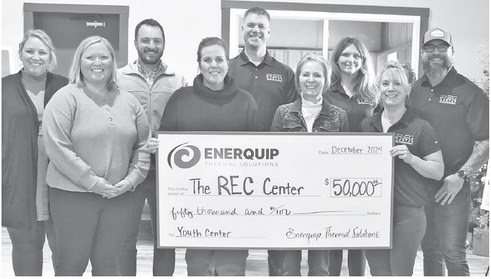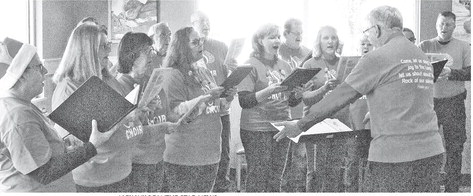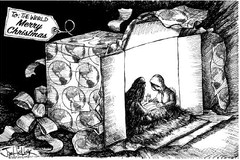Rib Lake artist transforms change to treasure


Three years ago, Sara Robisch of Rib Lake started making rings out of coins after her husband introduced her to the idea.
Robisch goes to Applefest in Bayfield annually to watch the Rib Lake band participate in the festival’s parade with her husband and Rib Lake’s band teacher, Matthew Robisch. Three years ago, her husband showed her a booth that made rings out of coins, saying he thought that they could make the rings themselves.
Robisch was intrigued by the idea and decided to research it.
“I looked up a lot of tutorials, and I figured out where to get the supplies from and we ordered the supplies and started trying it out,” said Robisch. She said that she and her family like to craft and are always looking for new projects and hobbies to try out. Making these rings is one that Robisch particularly enjoys.
Robisch said that she started off by making rings out of quarters because they were the easiest coin to transform. She also had some foreign coins from when she went to Germany in high school, so she made rings out of those as well. Some friends also gave her coins to try out. She explained that when her family first got into the hobby, they tried out a bunch of different things.
Currently, Robisch sells her rings at Personalized Treasures located at 814 McComb Ave. in Rib Lake. She explained that she’s happy with how her business is as it’s just something she does for fun.
“It’s just kind of a fun thing to do and we’re friends with the people who own Personalized Treasures, so it’s nice to have a place to sell them,” said Robisch.
Robisch has made rings for herself, including one made out of a quarter from her birth year. For selling them at Personalized Treasures, she makes mostly ones out of quarters. She bought a variety of Wisconsin quarters to make to sell. She wasn’t sure what people would like and thought that the Wisconsin ones would be appealing to customers.
“The quarters sell the most, and it seems to be the bigger sizes so I’m thinking men buy them more,” said Robisch.
With a special kit she’s purchased, Robisch is able to make rings of all widths and sizes. She ordered a lot of her tools from Jason’s Works, a company that sells tools and provides tutorials for making rings out of coins. Robisch recommends his products to anyone interested in making these rings.
“If anybody wants to try it themselves, that’s where they would want to [find tools]. He’s got great books and tutorials and a website. There’s also Facebook groups that you can join if you’re interested,” said Robisch.
Robisch uses a hole punch kit that allows her to change the width of the band. The smaller the hole, the wider the band, while larger holes make narrower rings. Her tools also make it easy for her to punch a hole directly in the center of the coin. She explained that some people don’t use the tools that she uses and freehand the hole punching step. Punching a hole in the center of the coin is the first step to making the rings.
After punching the desired sized hole into the coin, Robisch uses a torch to heat up and anneal the coin to make it soft enough to work with and bend. “Usually with quarters I only have to anneal it once. Some of the other coins, they harden up really fast and then you just can’t work with them,” said Robisch.
From there, Robisch uses a device called a ring stretcher reducer in order to get the coin from being flat to being in the shape of a ring. Using this device and what are called reducing dies, she bends the metal into a cone shape.
“It’s called folding, so you push it down and it’s going to push it into a cone shape,” said Robisch. She starts with a metal reducing die, and then does the same step again with another reducing die to fold it even more so it’s more of a volcano shape, as Robisch described it.
After that, Robisch uses the top of the stretcher part of the device to stretch the ring out to be at least two sizes bigger than the size she wants. Then she puts the ring back into the reducer part of the device and presses the ring into the actual band shape. This step also reduces the size of the ring to get it to the desired size.
“You just kind of play around because you don’t have to press it very hard to get it to shrink. So you can go too far pretty quickly,” said Robisch.
If Robisch makes the ring too small by accident, she’ll stretch it out again until it’s the correct measurement. She owns a ring mandrel that helps her measure the size of the ring so she’s able to get it right. She also owns a set of ring sizers for people to measure their fingers to gauge the proper size if she’s making a personalized ring for a specific person.
Once the ring is in its proper form and is the correct size, Robisch sands and shines it to make it look nice and smooth. She’ll then seal the ring, especially if it’s a quarter.
“Quarters have copper in them, so they’ll turn your finger green. So I also seal them with a clear sealer. You can also use fingernail polish,” said Robisch.
Robisch explained that the tools she uses makes the process a lot easier and go much smoother. Not only do the tools make it easier, but also make the quality of the rings a lot better. The tools ensure the same consistent quality with each ring she makes. “The tools really help. I thought it would be a little bit harder. We did do a lot of reading up on it before we ordered the tools,” said Robisch. “If you have the right tools, it’s not that hard.”
While she now sells the rings in an actual store, people have also come to her to place orders for specific rings. “Sometimes people want certain years. Sometimes people need certain sizes,” said Robisch. For Christmas, she made a number of rings for a family whose son had a lot of foreign currency from his travels.
While quarters are the easiest to make and sell the most, Robisch can make rings out of any coins. Different coins have different colors and thicknesses that create a variety of different styles of rings. Ten cent coins from the Bahamas have a wavy outline, so those rings have a wavy edge on them.
“[The gold dollar coins] and the Susan B. Anthony’s are interesting because they are really thick and big so they’re kind of tricky to do,” said Robisch. Sometimes she has to ask her oldest son for help to reduce those rings because they require more strength to press them into shape.
All three of her sons have made rings with Robisch, although she said that her oldest son enjoys making them the most. She said that she enjoys making the rings and is happy that she’s able to sell them to other people.

Sara Robisch
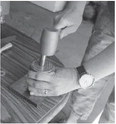
Robisch starts the process by punching a hole into the coin. She able to make different sized holes in the coins to adjust the band width of the ring.
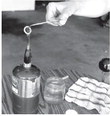
After the center hole is punched out, the coin must be annealed, or heated up, so it is softer. From here, she’s able to bend and fold it intoshape.
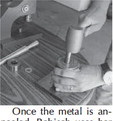
Once the metal is annealed, Robisch uses her ring reducer and reducing dies to start folding the coin into a cone shape. The tall slim top of this device is then used tostretch the ring out.

From a flat coin to a ring, Robisch goes through a series of steps to shape the metal coin into the proper size and shape. Using tools, she folds and stretches the metal before shining and polishing it.
